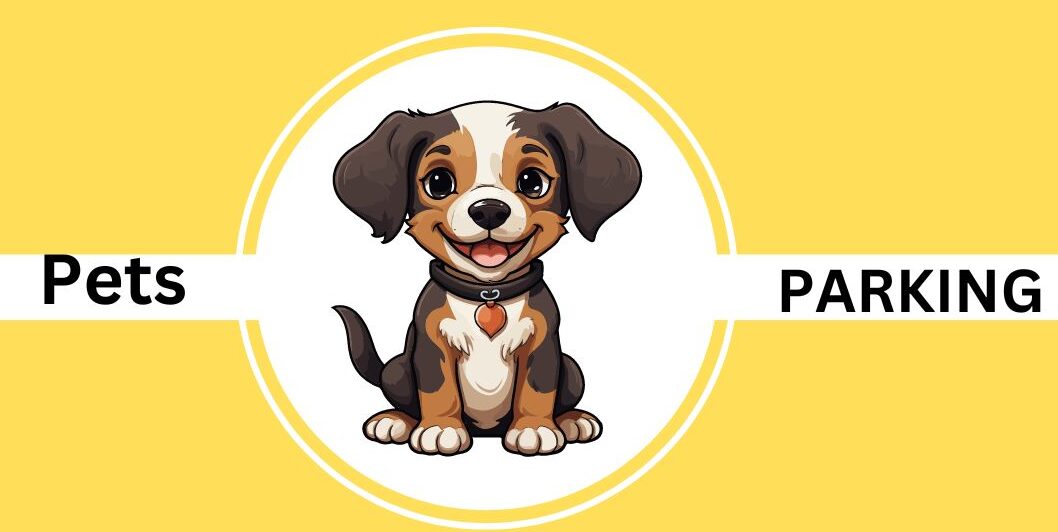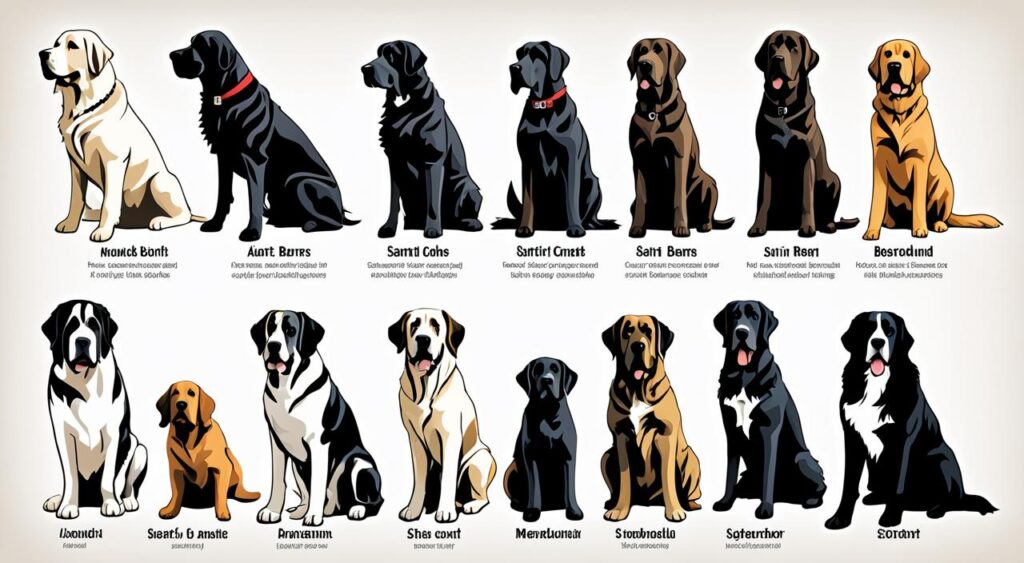Ever thought about living with one of the biggest dog breeds? It’s exciting and a bit scary for many. This section looks at the top 20 largest dog breeds. We focus on ten amazing dogs known for their weight, charm, and loyalty.
Breeds like the Mastiff and Great Dane are big but also loving and protective. They’re not just big; they’re also great companions and guardians. You’ll see how their size and strength make them special in family life.
Key Takeaways
- This article highlights the top 20 largest dog breeds by weight.
- Giant breeds like Mastiffs and Great Danes offer unique companionship.
- The size of large dog breeds can bring both advantages and challenges.
- Understanding the characteristics of these breeds helps in making informed pet choices.
- These gentle giants can provide both protection and affection.
Introduction to Large Dog Breeds

Large dog breeds have won the hearts of many dog lovers worldwide. They include a mix of impressive dogs known for their size, strength, and unique traits. Each breed has its own special charm, fitting different lifestyles and preferences.
Historically, big dogs played key roles like guarding, hunting, and helping farmers herd animals. Their skills have been improved over time, making them dependable in many tasks. People love these dogs for their size, loyalty, and friendship.
It’s important for potential owners to know what large dogs need. They need lots of space, regular exercise, and consistent training. Without these, their size can cause problems at home. So, it’s key to think about these things before getting a giant breed dog.
| Characteristic | Importance |
|---|---|
| Space | Large dog breeds need room to roam and play, preventing stress and anxiety. |
| Exercise | Regular physical activity is essential to maintain a healthy weight and prevent behavioral issues. |
| Training | Early training and socialization help large dogs become well-adjusted and safe companions. |
| Nutrition | High-quality diet that meets their energy needs is vital to their growth and overall health. |
Knowing what it takes to own a giant breed dog prepares future owners for a great experience. With the right care, large dogs can bring a lot of happiness to any home.
The Significance of Size in Dog Breeds
Size is key in classifying dog breeds, especially for the giants. These big dogs need extra care, training, and health attention. Knowing about size helps owners make better choices for their pets.
Larger dogs often face health issues like hip dysplasia and heart problems. Regular vet visits and a healthy diet are vital for their well-being. They also need exercises that fit their size and health.
Owners should learn about the needs of giant breeds. This knowledge helps in giving them the right care. It also helps in keeping them healthy and happy.
| Size Category | Common Health Risks | Care Tips |
|---|---|---|
| Giant Dog Breeds | Hip Dysplasia, Heart Problems | Regular Vet Check-ups, Controlled Exercise |
| Large Dog Breeds | Obesity, Bloat | Balanced Diet, Consistent Weight Monitoring |
| Medium Dog Breeds | Less Serious but Potential Joint Issues | Routine Physical Activity, Health Screening |
Overview of Giant Breed Dogs
Giant breed dogs are known for their impressive size and rich history. They have been companions, guardians, and workers for humans over the years. Breeds like the Mastiff and Great Dane are famous for their loyalty and protective nature.
Each giant breed has its own set of traits suited for different roles, from being family pets to protecting livestock. Their size demands respect, yet they can be gentle and friendly. It’s important to understand their history and the care they need.
Having a giant breed dog can bring a family closer through loyalty and love. With the right care and training, these dogs become a valued part of the family. They add to the family’s life in significant ways.
Characteristics of Large Dog Breeds
Large dog breeds, often called massive dog breeds, have unique traits. They have a strong, robust body and are physically strong. These big dogs are often gentle, making them great for families.
They are very loyal to their human families. They form strong bonds and can be protective. Yet, they are also very affectionate, acting as both guardians and loving family members.
When picking a large breed, consider these traits:
- Gentle temperament: Many large breeds are kind and loving.
- Strong loyalty: These dogs form close bonds with their owners and families.
- Protective instincts: Their size helps keep strangers away, making them good watchdogs.
- Playful spirits: Despite their size, many love to play and be active.
Knowing these traits helps people choose the right large dog breed for their family.
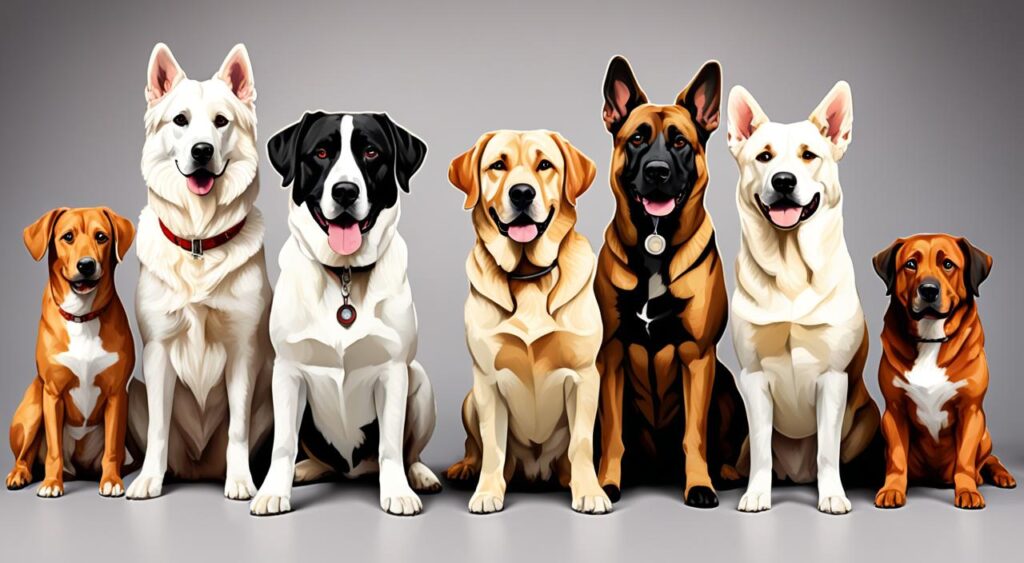
Top 20 Largest Dog Breeds
Dog lovers find the biggest canines fascinating. The top 20 largest dog breeds show a mix of traits, temperaments, and needs. Each breed has its own history and purpose. This makes understanding their size and weight important for future owners.
A Brief Look at the Top Breeds
Here are the top 20 largest dog breeds. They vary in weight and have unique characteristics.
- Mastiff: Over 230 pounds
- Saint Bernard: 140 to 180 pounds
- Great Dane: 110 to 175 pounds
- Leonberger: 90 to 170 pounds
- Newfoundland: 100 to 150 pounds
- Neapolitan Mastiff: 110 to 150 pounds
- Tibetan Mastiff: 90 to 150 pounds
- Anatolian Shepherd: 80 to 150 pounds
- Irish Wolfhound: 90 to 150 pounds
- Great Pyrenees: 85 to 115 pounds
- Boerboel: 110 to 200 pounds
- English Mastiff: 120 to 230 pounds
- Dogue de Bordeaux: 110 to 145 pounds
- Rottweiler: 80 to 135 pounds
- Black Russian Terrier: 80 to 140 pounds
- Scottish Deerhound: 85 to 110 pounds
- Komondor: 80 to 130 pounds
- Filipino Askal: 70 to 130 pounds
- American Bulldog: 70 to 120 pounds
- Chow Chow: 45 to 100 pounds
Comparison of Weight and Size
Comparing these breeds shows interesting facts about their traits. Below is a table that lists their weight and size. It helps potential adopters understand the dog breed weight comparison.
| Breed | Weight Range (lbs) | Height (inches) |
|---|---|---|
| Mastiff | 230+ | 27-30 |
| Saint Bernard | 140-180 | 26-30 |
| Great Dane | 110-175 | 28-34 |
| Leonberger | 90-170 | 25-31 |
| Newfoundland | 100-150 | 26-30 |
| Neapolitan Mastiff | 110-150 | 24-30 |
| Tibetan Mastiff | 90-150 | 24-30 |
| Anatolian Shepherd | 80-150 | 27-30 |
| Irish Wolfhound | 90-150 | 30-34 |
| Great Pyrenees | 85-115 | 25-32 |
| Boerboel | 110-200 | 24-30 |
Mastiff: The Gentle Giant
The mastiff is a giant dog breed known for its huge size and loving nature. It’s easy to see why they’re called gentle giants. They have a big size and a heart of gold.
Physical Features of Mastiffs
Mastiffs have unique looks that set them apart. They often have:
- Broad heads that show strength and stability
- Muscular builds that show their power
- A weight range of about 120 to 230 pounds, making them very heavy
- Short coats in colors like fawn, brindle, and apricot
These features help them look impressive and serve a purpose. They are great guardians and loyal friends.
Temperament and Family Life
Mastiffs are protective but gentle, making them perfect for families. They are known for:
- Deep loyalty to their families, forming strong bonds with everyone
- Calm and easygoing nature, fitting well into any home
- Affectionate behavior, loving to be around kids and other pets
This makes them not just one of the biggest dog breeds. They are also loved and trusted companions.
Boerboel: Protector of the Home
The Boerboel is a strong and protective breed from South Africa. It has a long Boerboel history as a guardian of homes and families. These dogs come from various mastiffs and are known for their size and loyalty. They are among the top protective dog breeds.
Origins and History of the Boerboel
Early settlers in South Africa bred Boerboels to protect their homes. They mixed different breeds with mastiffs to create a dog that’s strong and great at guarding. Boerboels can tell when something is a threat, making them perfect family protectors.
Training and Care Needs
Boerboels need training and socializing early to be good pets. Training should be firm but kind. They need daily exercise to keep them happy and healthy. Owners should give them lots of activities to do and make sure they feel like part of the family.
| Characteristic | Details |
|---|---|
| Height | 24 to 28 inches |
| Weight | 110 to 200 pounds |
| Lifespan | 10 to 12 years |
| Temperament | Loyal, protective, and alert |
| Exercise Needs | High, requires daily activity |
| Trainability | High, responds well to consistent training |
Tosa Inu: The Uncommon Giant
The Tosa Inu is a rare dog breed known for its tall size and deep history. It comes from Japan and was once bred for fighting, showing off its strength and speed. Now, it has changed to be a loving family pet and a true guardian.
This breed has a strong body and muscles that make it look both powerful and beautiful. They usually weigh 90 to 200 pounds and can grow to be 24 to 32 inches tall. Their short coat comes in many colors and needs little care, making them a good choice for those who want a pet that’s easy to look after.
The Tosa Inu is known for being calm but also very protective. They form strong emotional connections with their owners, showing loyalty that’s hard to find. It’s important to socialize and train them early to help them become great pets.
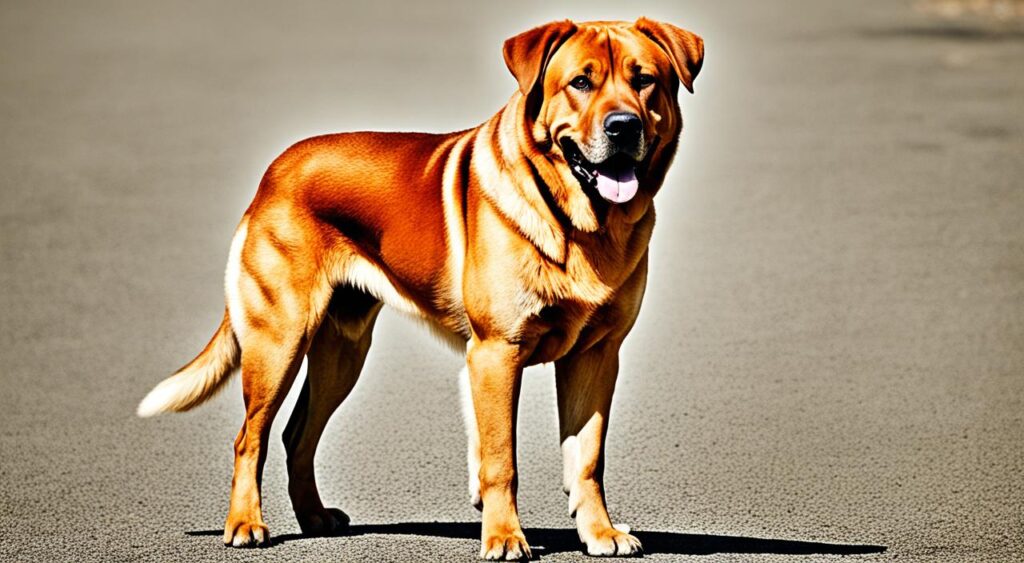
| Feature | Description |
|---|---|
| Size | Large, 90-200 lbs |
| Height | 24-32 inches |
| Coat | Short and easy to groom |
| Temperament | Calm, loyal, protective |
| Origin | Japan |
| Category | Rare dog breeds |
To truly understand the Tosa Inu, you need to appreciate its special background and nature. This breed is one of the rare giants in the dog world. They offer companionship that’s hard to find, perfect for those who see the beauty in their strength and gentleness.
Saint Bernard: The Rescue Dog
The Saint Bernard breed is known for its history as a rescue dog in the Swiss Alps. They were trained to help travelers in snowstorms. Their size and gentle nature have made them a favorite among dog lovers. Learning about Saint Bernard history shows why they’re great family pets and adventure buddies.
Saint Bernard’s Role in History
The Saint Bernard’s story began at the Great St. Bernard Pass in the Swiss Alps. Monks bred them for rescue work. These dogs have a long history of bravery, saving many lives over the years.
Their strength and sense of direction helped them find lost travelers in the snow. They guided these people to safety during harsh winters.
Caring for Saint Bernards
Looking after a Saint Bernard means paying attention to their needs. They need regular grooming to keep their thick fur clean. A balanced diet is key to their health, as they can easily become overweight.
They also need daily exercise to stay fit and happy. This keeps them active, just like their rescue dog ancestors.
Great Dane: Majestic and Tall
The Great Dane is a giant among dogs, known for its impressive height. They can grow up to 32 inches tall. This breed is both elegant and strong, with a playful and loving nature. They make great pets for families and individuals.
Height Comparisons with Other Breeds
Great Danes stand out when compared to other large dogs because of their height. Here’s a table that shows how they compare to other tall dog breeds:
| Breed | Average Height (inches) | Category |
|---|---|---|
| Great Dane | 28 – 32 | Tallest Dog Breed |
| Irish Wolfhound | 30 – 34 | Tallest Dog Breed |
| Newfoundland | 26 – 28 | Large Dog Breed |
| Saint Bernard | 26 – 30 | Large Dog Breed |
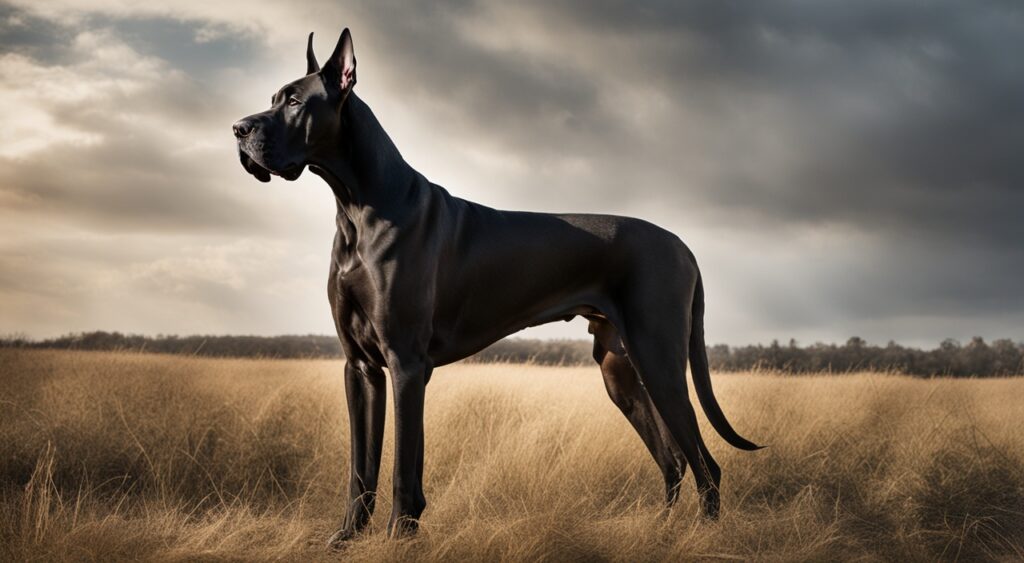
The table shows how the Great Dane towers over other dogs. Their tall stature makes them a standout. They are known for their size, loyalty, and gentle nature. This makes them a beloved part of many families.
Leonberger: The Lion-like Companion
The Leonberger is a stunning breed, often seen as a gentle giant. They look a lot like a lion. Their big size and beautiful coat make them stand out. They are perfect family dogs because they are so friendly.
These dogs come from Germany and were first bred in the 19th century. They were meant to be both companions and working dogs. Leonbergers are loved for their loyalty and friendly nature. They can live in many homes, big or small, as long as they get enough exercise and meet other dogs.
People say Leonbergers are smart and love to please, which helps with training. Teaching them early and socializing them helps them grow into well-behaved adults. With the right training, they can be protective but still friendly. This makes them great with families and kids.
In short, Leonbergers are perfect for families. They are loyal, adaptable, and loving. If you want a dog that brings joy, loyalty, and protection, the Leonberger is a great choice.
Neapolitan Mastiff: The Unique Look
The Neapolitan Mastiff is a standout among dog breeds with its unique look. It has a big, strong body and lots of wrinkles. These dogs are both elegant and strong, making them both impressive and lovable.
They have a wide head, deep eyes, and loose skin. This look is not just for show; it helps protect them from injuries during fights. In the past, they were used as guardians and fighters.
Appearance and Lifespan
This breed weighs between 110 to 150 pounds. They are 24 to 31 inches tall at the shoulder, showing off their powerful build. Their coat is short and smooth, coming in colors like brindle, black, and fawn.
On average, a Neapolitan Mastiff lives 8 to 10 years. They are known for their noble look and loyal nature. But, they can have health issues like hip dysplasia and heart problems. Owners should take them to the vet regularly and make sure they eat well, exercise, and get along with others.

Newfoundland: The Water Lover
Newfoundlands are famous for their amazing swimming skills and kind nature. These big dogs love being active and social. It’s important to know how to care for them, especially their love for water and how they get along with kids.
Caring for Newfoundlands
Looking after Newfoundlands means paying attention to a few key things. They need regular grooming to keep their thick, water-repelling coat in good shape. This coat keeps them warm when they’re in cold water. Here’s what you should know about caring for a Newfoundland:
- Grooming: Brush their coat at least twice a week to reduce shedding and mats.
- Exercise: Daily walks and swimming sessions are vital to maintain their physical health.
- Diet: Provide high-quality dog food that meets their nutritional requirements.
- Veterinary Care: Regular checkups ensure their health and help to identify any potential issues early.
Newfoundlands and Children
Newfoundlands are often seen as one of the best big dogs for families. They are calm and loving, making them great with kids. Here are some things to keep in mind when Newfoundlands and children are together:
- Gentle Nature: Newfoundlands are known for their patient and loving temperament.
- Supervision: Always supervise interactions between dogs and young children to ensure safety.
- Trainability: They respond well to positive reinforcement training, enhancing their social skills around kids.
Anatolian Shepherd: Guardian of Livestock
The Anatolian Shepherd is a breed known for its protective breeds traits. It’s perfect for guarding livestock. Coming from the Anatolian region of Turkey, this dog has protected flocks for centuries. It has a strong instinct to defend against predators like wolves and bears.
These dogs are independent and smart. They work well alone, using their common sense to make decisions. This makes them great for families, if they’re trained and socialized well.
Training an Anatolian Shepherd needs to be firm but kind. Use positive reinforcement to avoid confusion. This builds trust and respect, important for this breed.
Socializing them is also key. Introduce them to different places and people early on. This helps them be less wary of strangers and other animals.
In short, the Anatolian Shepherd is loyal, independent, and protective. By understanding and supporting these traits, families can have a great pet.
Tibetan Mastiff: The Ancient Guardian
The Tibetan Mastiff is a standout among ancient dog breeds, known for its tall stature and deep history. These dogs were once guardians in monasteries, showing their protective nature and loyalty. It’s important for potential owners to understand the breed’s traits, as they have unique needs.
Behavior and Temperament
This breed is often quiet and keeps an eye on strangers. Yet, they are very loyal and loving to their families. It’s key to socialize them early to manage their protective instincts. Training should use positive methods to build a respectful and obedient bond.
Here’s a table with key traits of the Tibetan Mastiff for potential owners:
| Trait | Description |
|---|---|
| Temperament | Aloof with strangers, loyal to family |
| Guarding Instinct | Strong protective instincts, defensive nature |
| Socialization Needs | Early exposure to various environments essential |
| Training | Requires consistent, positive reinforcement methods |
Knowing these traits helps prepare potential owners for the responsibilities of having this breed. With careful thought and proper training, these ancient guardians can make great companions.
Additional Recognized Giant Breeds
The giant dog breeds list includes many breeds beyond the usual ones. The Rottweiler is one, known for its strength and loyalty. It’s protective but also great with families if trained right.
The Bullmastiff is another breed to note for its calm and loving nature. It’s a large breed that’s gentle and makes a good family pet. It’s also a reliable guardian of the home.
The Great Pyrenees is famous for its majestic look and loyalty to its family. It’s both gentle and alert, ideal for those wanting a loyal friend.
The Irish Wolfhound stands out with its tall stature and friendly nature. Despite being large, they’re gentle and great with kids. They make excellent family pets.
Here’s a table that compares some giant dog breeds. It shows their size, temperament, and how well they fit as family pets or working dogs.
| Breed | Size (Weight) | Temperament | Family Suitability |
|---|---|---|---|
| Rottweiler | 80-135 lbs | Loyal and Protective | Very Good |
| Bullmastiff | 100-130 lbs | Calm and Affectionate | Excellent |
| Great Pyrenees | 85-115 lbs | Gentle and Vigilant | Very Good |
| Irish Wolfhound | 90-150 lbs | Good-natured | Excellent |
Tips for Owning a Large Dog
Owning a large dog is rewarding but comes with challenges. Using large dog ownership tips helps make life together smoother. Make sure you have enough space for your dog to move around. A big backyard or a park nearby can make them very happy.
What your dog eats is key to their health. Large dogs need more food, based on their breed and age. Choose high-quality food that fits their needs. But, don’t overfeed them to avoid obesity and health problems.
Big dogs need lots of exercise to stay fit and happy. Try to walk or play with them every day. This helps them burn off energy and stay well-behaved.
Grooming is crucial for caring for big dogs. Some dogs need grooming more often to keep their coat and skin healthy. Brushing them regularly helps prevent mats and keeps their coat shiny.
Training a large dog is a must. They need consistent, positive training to avoid behavior issues. Training classes can really help new owners and their big dogs.
To summarize, here’s a quick guide:
| Aspect | Tips |
|---|---|
| Living Space | Ensure enough room for movement; consider a yard. |
| Diet | Provide high-quality food specific to their breed and age. |
| Exercise | Aim for daily walks and playtime; socialization is key. |
| Grooming | Brush regularly to minimize shedding and maintain healthy skin. |
| Training | Use positive reinforcement; consider professional training classes. |
Following these tips can make life with your large dog better for both of you. It will strengthen your bond and keep your dog healthy and happy.
Health Considerations for Big Dogs
Owning a large dog means you have special health care needs. Big dogs often face issues like joint problems, heart conditions, and bloat. It’s key to catch these early with regular vet visits. Taking care of their health helps them stay happy and healthy.
Joint problems are common in big breeds like Great Danes and Mastiffs. They can have hip and elbow dysplasia because of their size and weight. Keep an eye out for signs like limping or trouble getting up. Keeping them at a healthy weight and adding joint supplements to their diet can help.
Heart conditions, such as dilated cardiomyopathy, are a big worry. This makes it hard for the heart to pump blood well. It’s important to get regular heart check-ups, especially if your breed is prone to it.
Bloat is a serious issue that can happen fast. Look out for signs like restlessness, a lot of drooling, or a big belly. Knowing these signs can help you act fast, which is key for big dogs.
Having insurance for your big dog is a big help. It covers vet visits, treatments for ongoing conditions, and emergencies. This gives you peace of mind and helps with the costs.
| Health Issue | Common Breeds Affected | Symptoms to Watch For | Preventive Measures |
|---|---|---|---|
| Joint Problems | Great Dane, Mastiff | Limping, Difficulty Rising | Maintain Healthy Weight, Joint Supplements |
| Heart Conditions | Boxer, Doberman | Fatigue, Coughing | Regular Screenings, Healthy Diet |
| Bloat | Great Dane, St. Bernard | Restlessness, Distended Abdomen | Smaller Meals, Elevated Food Bowls |
Conclusion
Owning a large dog breed is deeply rewarding. It brings loyal and protective companionship. These dogs create a strong bond with their owners and make homes safer.
From the comforting Great Dane to the gentle Mastiff, these dogs add joy to family life. They offer emotional support, encourage physical activity, and bring happiness with their majestic presence.
But, owning a large dog comes with big responsibilities. It’s important to research their needs for space, exercise, and health care. This ensures a happy and healthy life for both the dog and the owner.
In summary, owning a large dog brings immense joy and fulfillment to families. By understanding the needs of giant breeds, families can build a strong bond with their dogs. This bond improves their lives in many ways.
FAQ
What are the top 20 largest dog breeds by weight?
The top 20 largest dog breeds include the Mastiff, Great Dane, Saint Bernard, Newfoundland, and Anatolian Shepherd, among others. These breeds are known for their impressive sizes. They can weigh anywhere from 100 to over 230 pounds.
What leads to the popularity of large dog breeds?
Large dog breeds are favored for their loyalty, protective instincts, and ability to form strong bonds with families. Their impressive size can also provide a sense of security in homes, making them endearing companions.
What special care do large dog breeds require?
Large dog breeds often require more space, regular exercise, and specific training to promote good behavior. Their unique physical needs include proper nutrition to support their size and active lifestyles.
Are giant breed dogs prone to health issues?
Yes, giant breed dogs are often susceptible to health concerns like hip dysplasia, heart problems, and other size-related conditions. Regular veterinary check-ups and a healthy lifestyle are essential for their well-being.
How do I choose the right giant dog breed for my family?
When selecting a giant dog breed, consider factors such as your living situation, activity level, and the specific needs of the breed. Researching their temperament and care requirements can help ensure a good match.
Are there any unique traits in giant dog breeds?
Many giant dog breeds share traits such as loyalty, gentle temperaments, and strong protective instincts. Each breed may also have unique characteristics that highlight its suitability for various roles, including companionship and guardianship.
Do large dog breeds get along well with children?
Yes, many large dog breeds, such as Newfoundlands and Saint Bernards, are known for their child-friendly nature. It’s important to supervise interactions and properly socialize the dog to foster a safe environment for both the dog and children.
What is the lifespan of giant breed dogs?
The lifespan of giant breed dogs is generally shorter than smaller breeds, often ranging between 7 to 10 years. Health maintenance and regular veterinary care can help maximize their lifespan.
How much exercise do large dog breeds need?
Large dog breeds typically require significant daily exercise, which can include walks, playtime, and mental stimulation. The specific needs can vary based on the breed, so regular activity is crucial for their physical and mental health.
What are common training challenges with large dog breeds?
Training large dog breeds can present challenges due to their size and strength. Socialization and obedience training are essential early on to manage their behavior effectively and ensure they are well-adjusted companions.
How do I manage the grooming needs of giant dog breeds?
Grooming needs vary by breed, but many large dog breeds require regular brushing to manage shedding and skin health. Bathing, nail trimming, and ear cleaning should be part of a consistent grooming routine to keep them healthy.
